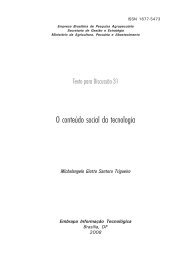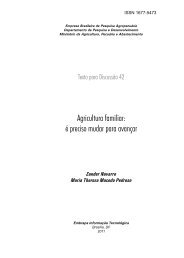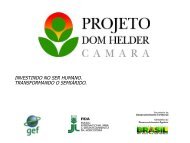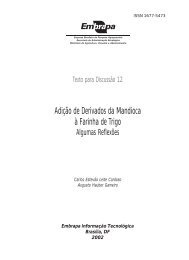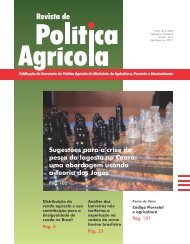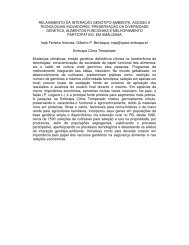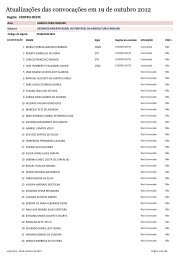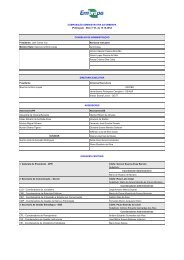Ministry of Agriculture, Livestock and Food Supply - Embrapa
Ministry of Agriculture, Livestock and Food Supply - Embrapa
Ministry of Agriculture, Livestock and Food Supply - Embrapa
You also want an ePaper? Increase the reach of your titles
YUMPU automatically turns print PDFs into web optimized ePapers that Google loves.
Current scenario <strong>and</strong> prospects<br />
The sugar & alcohol industry currently capitalizes on a set <strong>of</strong> favorable<br />
factors both domestically <strong>and</strong> internationally.<br />
In the domestic front the economy's recovery <strong>and</strong> the new jobs being<br />
generated have resulted in sugar consumption increasing in excess <strong>of</strong> the<br />
natural growth rate <strong>of</strong> the population, although Brazil has one <strong>of</strong> the highest<br />
sugar consumption rates in the world (close to 54 kg/inhabitant/year).<br />
As regards alcohol, consumers are again interested in alcohol-fueled<br />
cars because <strong>of</strong> the increased domestic gasoline prices, the prospects <strong>of</strong><br />
more increases in the international petroleum prices <strong>and</strong> the new dual fuel<br />
vehicles. Barely two years after their coming into the market dual fuel vehicles<br />
account for 70% <strong>of</strong> new vehicle sales in the country. Consequently, hydrated<br />
alcohol is once again very good business, especially in the cities located in<br />
the sugar & alcohol regions. Nevertheless, if the sugar & alcohol industry<br />
raise fuel alcohol prices, it would have a deleterious effect on dual fuel vehicle<br />
sales, as befell alcohol-fueled cars in the past, which became practically<br />
unviable. The government, therefore, should watch the market carefully.<br />
It is estimated that the market will absorb at least one million dual fuel<br />
vehicles per year during the next few years, which would represent a hydrated<br />
alcohol18 dem<strong>and</strong> increase in excess <strong>of</strong> 1.5-billion liters p.a. <strong>and</strong> an estimated<br />
dem<strong>and</strong> <strong>of</strong> 25-billion liters by 2013. After adding the predicted alcohol sales in<br />
international markets, it is possible to imagine an overall ethanol dem<strong>and</strong> <strong>of</strong><br />
close to 30-billion liters by 2015, which could be easily met by the Brazilian<br />
sugar & alcohol industry.<br />
These projections lead to an estimated domestic sugarcane dem<strong>and</strong><br />
leap from 240-million tons (70-million tons <strong>of</strong> sugarcane for sugar production<br />
<strong>and</strong> 170-million for alcohol) to about 334-million tons (84-million tons <strong>of</strong> sugarcane<br />
for sugar production <strong>and</strong> 250-million tons for alcohol) in the next five years, a<br />
production increase <strong>of</strong> practically 100-million tons for the domestic market.<br />
In the international markets the situation is also heartening for sugar,<br />
which in Brazil competes with ethanol for the same raw material. A world<br />
consumption increase <strong>of</strong> about 2% p.a. would help the growth <strong>of</strong> Brazilian<br />
exports. Moreover, the expected reduction in sugar production that should<br />
take place in several countries investing in fuel alcohol production without the<br />
18 Assuming that the vehicles' average annual consumption is 2,000 liters <strong>and</strong> subtracting 500,000 liters/<br />
year on account <strong>of</strong> the alcohol cars in the fleet growing old.<br />
75



